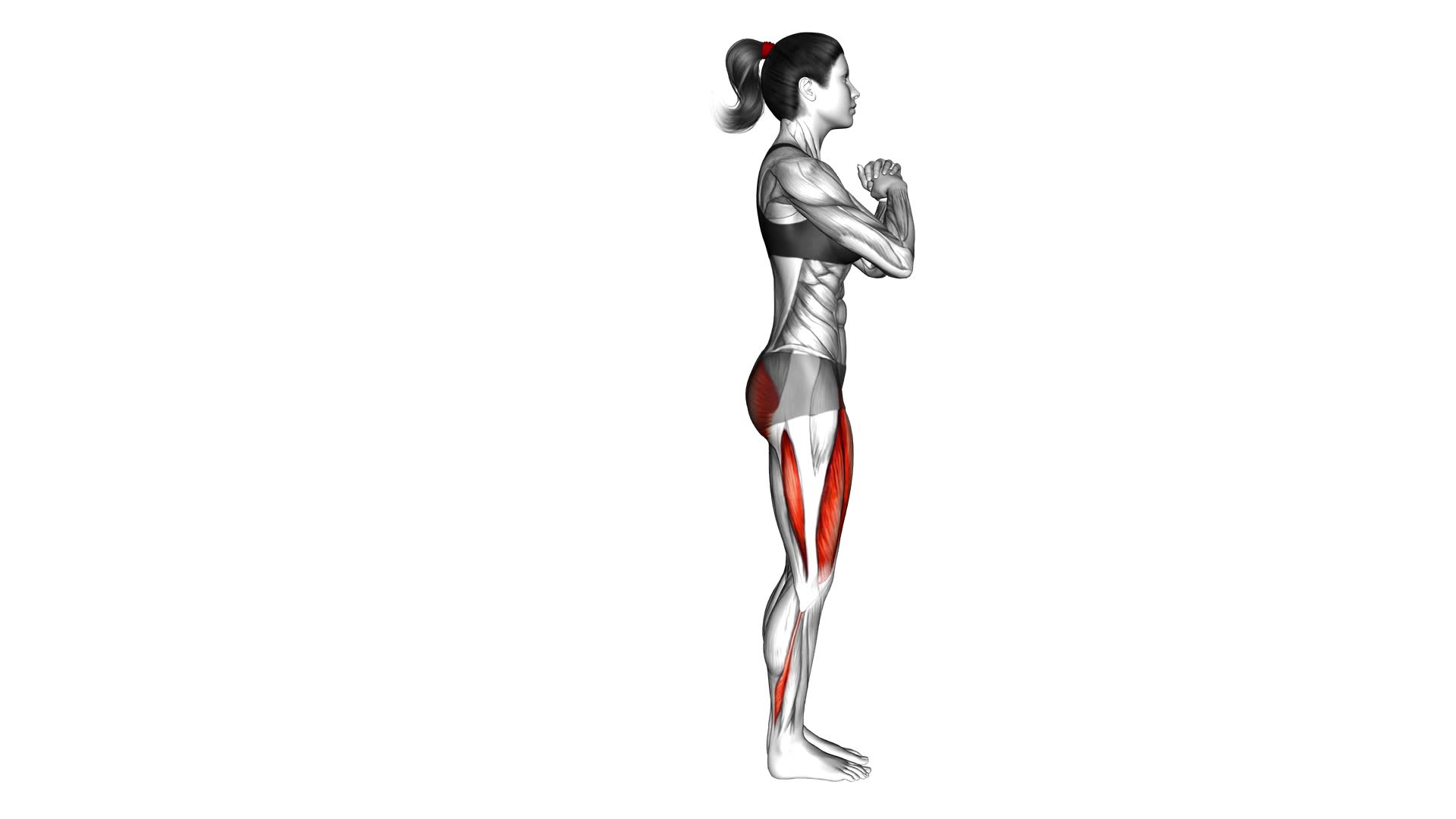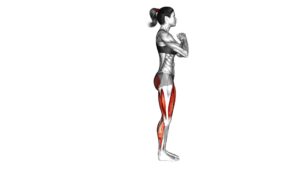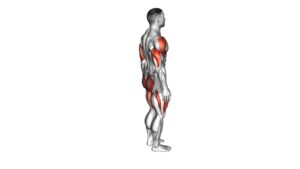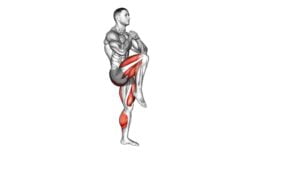Bodyweight Reverse Lunge (female) – Video Exercise Guide & Tips

Are you looking for an effective lower body exercise that doesn't require any equipment? Look no further than the bodyweight reverse lunge.
Watch This Exercise Video
This exercise targets your glutes, quads, and hamstrings, helping you build strength and improve your balance.
In this video exercise guide, we'll show you the proper technique for performing bodyweight reverse lunges and provide helpful tips to maximize your results.
Get ready to take your fitness routine to the next level with this challenging yet rewarding exercise.
Let's get started!
Key Takeaways
- Bodyweight reverse lunges target the glutes, quads, and hamstrings.
- Proper technique includes standing with feet hip-width apart and stepping back with one leg, lowering the body until the front thigh is parallel to the ground.
- Common mistakes to avoid during bodyweight reverse lunges include allowing the front knee to cave inward and not fully extending the hips at the top of the movement.
- Advanced variations of bodyweight reverse lunges include adding resistance, incorporating plyometric movements, and using unstable surfaces or equipment.
Benefits of Bodyweight Reverse Lunges
Experience the numerous benefits of incorporating bodyweight reverse lunges into your fitness routine. Bodyweight reverse lunges are an effective exercise for improving balance and strengthening leg muscles. By performing this exercise regularly, you can achieve a more stable and balanced body, as well as develop stronger leg muscles.
When you engage in bodyweight reverse lunges, you're required to maintain your balance throughout the movement. This not only challenges your leg muscles but also activates your core muscles, contributing to overall stability. As you become more proficient in this exercise, your balance will improve, making everyday activities easier and reducing the risk of falls or injuries.
Additionally, bodyweight reverse lunges target and strengthen the leg muscles, including the quadriceps, hamstrings, and glutes. These muscles play a vital role in daily activities such as walking, climbing stairs, and lifting objects. By regularly incorporating bodyweight reverse lunges into your routine, you can enhance the strength and endurance of these muscles, leading to improved performance in various physical activities.
Proper Technique for Bodyweight Reverse Lunges
To perform bodyweight reverse lunges correctly, start by standing with your feet hip-width apart. Keep your chest up and engage your core for stability. Here are some key tips to help you execute this exercise with proper technique:
- Step back with one leg, landing on the ball of your foot.
- Lower your body until your front thigh is parallel to the ground, keeping your knee in line with your ankle.
- Push through your front heel to return to the starting position.
- Repeat on the other side, alternating legs for each repetition.
Common mistakes during reverse lunges include:
- Allowing your front knee to cave inward.
- Leaning too far forward or backward.
- Not fully extending your hips at the top of the movement.
To make reverse lunges more challenging, you can try the following variations:
- Add dumbbells or a barbell to increase resistance.
- Incorporate a jump at the top of the movement for an explosive plyometric exercise.
- Perform the lunges on an unstable surface, such as a balance board or Bosu ball, to engage more stabilizer muscles.
Common Mistakes to Avoid During Bodyweight Reverse Lunges
To avoid common mistakes during bodyweight reverse lunges, make sure that you don't allow your front knee to cave inward. Maintaining proper form is crucial to getting the most out of this exercise and preventing injury.
One of the most common mistakes people make is allowing their front knee to collapse inward towards the center of their body. This can put excessive strain on the knee joint and increase the risk of injury. To avoid this, focus on keeping your knee in line with your toes throughout the movement. Imagine there's a straight line running from your hip, through your knee, and down to your ankle. This will help you maintain proper alignment and distribute the load evenly between your hip, knee, and ankle joints.
Another common mistake isn't maintaining a stable core throughout the exercise. Engaging your core muscles will help stabilize your body and prevent excessive swaying or leaning. Focus on keeping your abdominal muscles tight and your spine neutral throughout the movement.
Advanced Variations of Bodyweight Reverse Lunges
For an added challenge and to further target your leg muscles, try incorporating compound movements into your bodyweight reverse lunges. These advanced modifications won't only engage your lower body but also activate your core and improve overall stability.
Here are three equipment options you can consider to take your bodyweight reverse lunges to the next level:
- Dumbbells: Hold a pair of dumbbells in your hands, one in each hand, while performing reverse lunges. This extra weight will increase the resistance and intensify the workout for your leg muscles.
- Resistance Bands: Attach a resistance band to a stable anchor point and loop it around your hips. As you perform the reverse lunges, the resistance band will provide continuous tension, making the exercise more challenging.
- Medicine Ball: Hold a medicine ball close to your chest while performing reverse lunges. The added weight won't only challenge your leg muscles but also engage your upper body, making it a full-body exercise.
Remember to maintain proper form and control throughout these advanced variations. Start with lighter weights or resistance bands and gradually increase the intensity as you become more comfortable and confident. Always listen to your body and modify the exercises based on your fitness level and any limitations you may have.
Tips for Incorporating Bodyweight Reverse Lunges Into Your Workout Routine
To effectively incorporate bodyweight reverse lunges into your workout routine, focus on proper form and gradually increase the intensity to challenge your leg muscles and improve overall stability.
Start by standing with your feet hip-width apart and your hands on your hips or by your sides. Take a step back with your right foot, landing on the ball of your foot, and lower your body until your left knee is bent at a 90-degree angle. Keep your torso upright and engage your core throughout the movement. Push through your left heel to return to the starting position and repeat on the other side.
To modify the exercise, you can use a chair or wall for support. Hold onto the chair or place your hand against the wall for balance as you perform the reverse lunge. This will help to reduce the strain on your legs and allow you to focus on maintaining proper form.
To progress and increase the difficulty of the bodyweight reverse lunges, you can add weights such as dumbbells or a barbell to increase the load on your muscles. You can also incorporate plyometric movements, such as jumping lunges, to increase the intensity and challenge your leg muscles even more.
Remember to always listen to your body and progress at a pace that feels comfortable for you.
Frequently Asked Questions
How Many Calories Does a Bodyweight Reverse Lunge Burn?
When you perform a bodyweight reverse lunge, you can expect to burn calories. The exact number of calories burned will vary depending on factors like your weight, intensity, and duration of the exercise.
However, it's important to note that the bodyweight reverse lunge is a compound movement that engages multiple muscle groups, making it an effective exercise for caloric burn.
For advanced exercisers, there are also variations available to increase the intensity and further maximize caloric expenditure.
Are Bodyweight Reverse Lunges Suitable for Beginners?
Bodyweight reverse lunges are a great exercise for beginners to strengthen their legs and improve balance. To ensure proper form, keep your chest up, shoulders back, and engage your core.
Avoid common mistakes like leaning too far forward or letting your front knee go past your toes.
Start with the basic variation by stepping back into a lunge and gradually progress to adding weights or performing jump lunges.
Remember to always listen to your body and start at your own pace.
Can Bodyweight Reverse Lunges Help Tone and Shape the Glutes?
Bodyweight reverse lunges are a great exercise for toning and shaping your glutes. By incorporating different variations of this exercise, you can target different areas of your glutes and make your workouts more challenging.
The benefits of bodyweight reverse lunges include strengthening your glutes, thighs, and core, improving your balance and stability, and increasing your overall lower body strength.
How Often Should Bodyweight Reverse Lunges Be Performed for Optimal Results?
To achieve optimal results with bodyweight reverse lunges, you need to consider the frequency of your workouts.
The frequency of performing bodyweight reverse lunges will vary depending on your fitness level, goals, and overall workout routine. It's generally recommended to incorporate this exercise 2-3 times per week.
However, be sure to listen to your body and adjust accordingly.
Additionally, you can also try different variations of bodyweight reverse lunges to target different muscle groups and keep your workouts challenging.
Can Bodyweight Reverse Lunges Be Modified for Individuals With Knee or Joint Pain?
If you're experiencing knee or joint pain, it's important to modify the bodyweight reverse lunge exercise.
There are several modifications you can try to alleviate the discomfort.
Instead of stepping back into a lunge position, you can try a stationary reverse lunge by just bending your knees and lowering your body down.
Another alternative exercise is the glute bridge, which helps strengthen your lower body without putting too much stress on your knees or joints.
Conclusion
Incorporating bodyweight reverse lunges into your workout routine can offer numerous benefits, including improved lower body strength and stability. By following proper technique and avoiding common mistakes, you can maximize the effectiveness of this exercise.
Advanced variations can challenge your muscles even further. Whether you're a beginner or advanced exerciser, bodyweight reverse lunges are a versatile exercise that can be easily incorporated into your routine.
Start reaping the benefits of this exercise today.

Author
Years ago, the spark of my life’s passion ignited in my mind the moment I stepped into the local gym for the first time. The inaugural bead of perspiration, the initial endeavor, the very first surge of endorphins, and a sense of pride that washed over me post-workout marked the beginning of my deep-seated interest in strength sports, fitness, and sports nutrition. This very curiosity blossomed rapidly into a profound fascination, propelling me to earn a Master’s degree in Physical Education from the Academy of Physical Education in Krakow, followed by a Sports Manager diploma from the Jagiellonian University. My journey of growth led me to gain more specialized qualifications, such as being a certified personal trainer with a focus on sports dietetics, a lifeguard, and an instructor for wellness and corrective gymnastics. Theoretical knowledge paired seamlessly with practical experience, reinforcing my belief that the transformation of individuals under my guidance was also a reflection of my personal growth. This belief holds true even today. Each day, I strive to push the boundaries and explore new realms. These realms gently elevate me to greater heights. The unique combination of passion for my field and the continuous quest for growth fuels my drive to break new ground.







